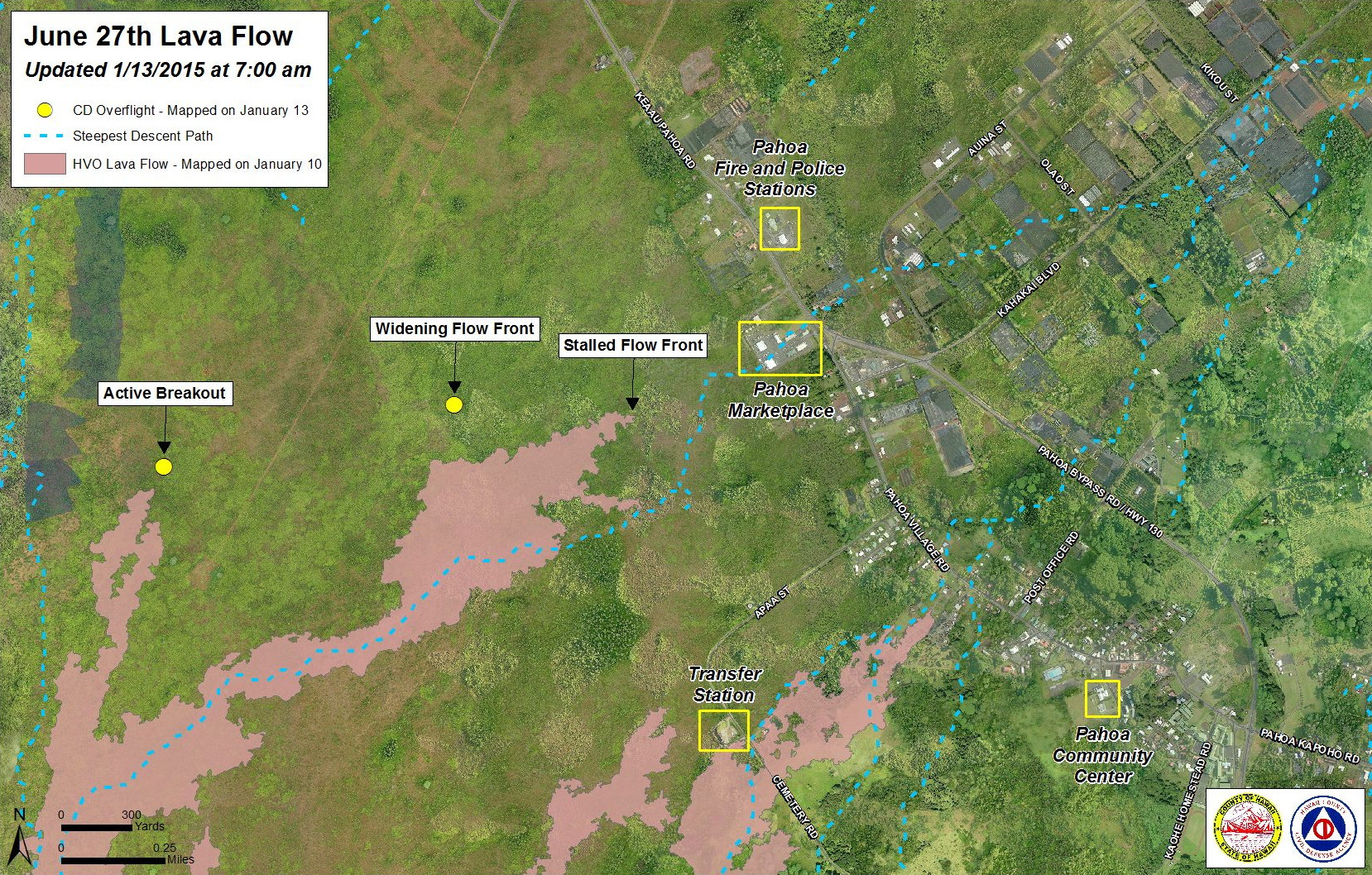(ABOVE) Photo taken over the lava flow yesterday (Jan. 12) by Hawaii County Civil Defense.
NEWS BRIEFS
- The flow front remains stalled half a mile from Highway 130.
- Surface activity and widening continues 300 yards upslope. Yesterday, civil defense began marking the distal tip of the widening flow on their daily map. Today USGS reported that the breakout may have sparked a brush fire.
- Two breakouts continue to move slowly, advancing only 20 yards since yesterday. The lobe is 1-1.5 miles behind the flow front, and has entered a drainage area leading to the steepest-descent path that crosses Highway 130 about .6 miles south of the Makuʻu Farmer’s Market.
- Heavy smoke and vog was noted during this morning’s overflight. A southwest wind was again blowing the smoke in a northeast direction over the areas of lower Puna through Hilo.
MEDIA
LATEST MAP

Civil Defense Lava Flow Map – Updated Tuesday, 1/13/15 at 7:00 am
PRIMARY SOURCES

This morning’s assessment shows that the flow front and south margin breakout remain stalled and there has been no advancement over the past week. The front or leading edge remains 0.5 miles upslope of the Highway 130 and Pahoa Village Road intersection. Some surface activity and widening continues approximately 300 yards above or upslope of the flow front. Two breakouts along the north margin approximately 1-1.5 miles upslope or behind the flow front remain active and have advanced approximately 20 yards since yesterday in a northeast direction. Other surface breakouts and activity along both margins continues upslope however, current activity does not pose an immediate threat to area communities. Civil Defense and Hawaiian Volcano Observatory personnel are maintaining close observations of the flow. Residents and businesses down slope will be kept informed of any changes in flow activity, advancement, and status.
Smoke and vog conditions were heavy with a southwest wind blowing the smoke in a northeast direction over the areas of lower Puna through Hilo. Smoke conditions may increase in some areas and individuals who may be sensitive or have respiratory problems are advised to take necessary precautions and to remain indoors.
On behalf of the Hawaii County Civil Defense Agency and our partners we would like to thank everyone for your assistance and cooperation. Hawaii County Civil Defense on Jan. 13 at 8:15 a.m. HST

Kīlauea Volcano continues to erupt at its summit and within its East Rift Zone. In the East Rift Zone, the tip of the June 27th lava flow remained stalled; however, active surface breakouts up slope of the front continued. A narrow flow lobe about 2.5 km (1.6 mi) upslope of Pahoa Marketplace continued to advance toward the north-northeast. This morning, Civil Defense reported that this lobe has advanced about 18 m (20 yds) since yesterday. DI inflationary tilt, along with a rising lava lake level, was recorded last night at the summit.
June 27th Lava Flow Observations: The flow that advanced toward Pahoa Marketplace in past weeks remained stalled approximately 800 m (0.5 miles or 880 yards) from the intersection of Highway 130 and Pāhoa Village Road; however, there were active breakouts about 275 m (300 ys) behind the stalled front this morning; one of these breakouts may have sparked a brush fire captured as rapid northward movement of smoke during the day and glow at night until midnight. In addition, the narrow flow lobe about 2.5 km (1.6 mi) upslope of Pahoa Marketplace advanced about 18 m (20 yds) toward the north-northeast since yesterday morning according to Hawai`i County Civil Defense. This lobe has entered a drainage area leading to the steepest-descent path that crosses Highway 130 about 1 km (0.6 mi) south of the Makuʻu Farmer’s Market, but the flow is still about 3.3 km (2.1 mi) uplsope from Highway 130 (straight-line distance to intersection of highway 130 and steepest descent line) and moving slowly. Other areas of surface lava were also active 0.9 – 3.5 km (0.5 – 2 mi) upslope of the Pahoa Marketplace during HVO’s most recent overflight on January 6. Breakouts further upslope, near the True/Mid-Pacific geothermal well pad, may also be active. The next overflight is panned for this afternoon, weather permitting.
Puʻu ʻŌʻō Observations: The tiltmeter on the north flank of Puʻu ʻŌʻō cone continued to record very weak inflation over the past 3+ days. All other monitoring data indicated no significant changes at Puʻu ʻŌʻō. The most recent measurement of sulfur dioxide emissions from all East Rift Zone vents was about 250 tonnes per day on December 19, 2014.
Summit Observations: DI inflationary tilt started at 6:20 pm last night as recorded at the summit. The summit lava lake quickly rose to its pre-DI event level while displaying minor lava level fluctuations associated with changes in spattering behavior, which are also manifested as variations in tremor amplitudes and gas release. Small amounts of particulate material were carried aloft by the plume. The average emission rate of sulfur dioxide was around 5,400 tonnes/day for the week ending on January 6.USGS Hawaiian Volcano Observatory on Jan. 13 at 9:03 a.m. HST

by Big Island Video News9:30 am
on at
STORY SUMMARY
The flow continues to widen behind the stalled front, while other breakouts slowly advance.